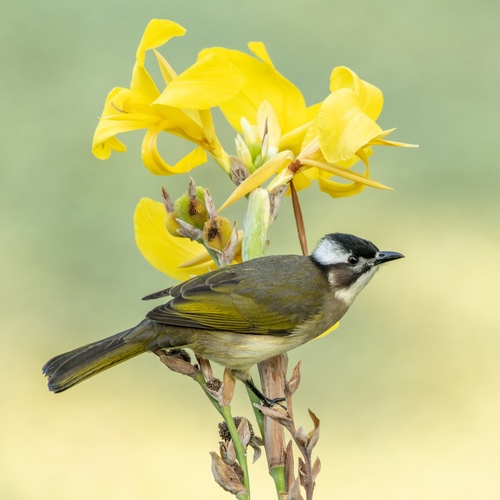
Light-vented Bulbul
The Light-vented Bulbul (*Pycnonotus sinensis*), also known as the Chinese Bulbul, is a widespread and adaptable songbird found across East Asia. It plays a significant ecological role as a seed disperser and insect consumer. While not globally threatened, it's a common sight in both urban and rural environments, often frequenting gardens, parks, and cultivated areas. The species holds some cultural significance in parts of its range, sometimes appearing in traditional art and folklore, and is known for its varied vocalizations.
18-20 cm
Length
25-28 cm
Wingspan
Least Concern
Conservation Status
Distribution
The Light-vented Bulbul is native to southern and eastern China, northern Vietnam, Taiwan, and parts of the Ryukyu Islands (Japan). It has also been introduced to other areas, such as Hawaii. It exhibits a wide altitudinal range, from lowlands to moderate elevations.
Lifespan
Unknown for wild individuals; potentially several years based on related species.
Light-vented Bulbul's Habitat
Habitat Types
Forest edges, Shrublands, Cultivated areas, Urban parks, Gardens, Secondary growth forests
Climate Zones
Subtropical, Temperate
Adaptations
The Light-vented Bulbul is highly adaptable to human-modified landscapes, thriving in both rural and urban environments. Its generalist diet allows it to exploit a variety of food sources, contributing to its success in diverse habitats.
Variations
Several subspecies are recognized, differing slightly in plumage coloration and size. For example, *P. s. sinensis* is found in mainland China, while *P. s. formosae* is endemic to Taiwan.
Appearance
Breeding Plumage
No significant difference between breeding and non-breeding plumage.
Seasonal Feather Changes
Minimal seasonal variation.
Sex Based Plumage Differences
Males and females have similar plumage.
Notable Features
Distinctive white patch on the nape, Black cap extending to the eyes, Grayish-brown upperparts, White underparts with a light vent (giving the species its name), Long tail
Diet and Feeding
Primary Foods
Fruits, Berries, Insects, Seeds, Nectar
Foraging Behavior
Light-vented Bulbuls are active foragers, often seen gleaning insects from foliage or feeding on fruits in trees and shrubs. They may also forage on the ground. They are typically seen in pairs or small groups.
Specializations
Their relatively slender bill is well-suited for consuming both insects and fruits.
Seasonal Diet Variations
Diet varies seasonally depending on food availability. They may consume more insects during the breeding season when protein requirements are higher, and more fruits and berries during other times of the year.
Behavior
Social Structure
Light-vented Bulbuls are often seen in pairs or small family groups. Outside of the breeding season, they may form larger flocks.
Communication
Variety of calls, including whistles, chirps, and chatters, A distinctive, melodic song used for territorial defense and mate attraction, Visual displays, such as fluffing feathers
Migration
Generally non-migratory, although some populations may make short-distance movements in response to food availability.
Territorial or Group Behaviors
During the breeding season, pairs are territorial and will defend their nesting area from other bulbuls. Outside the breeding season, they are more social and may form foraging flocks.
Conservation
Threats
Habitat loss due to urbanization and agricultural expansion, Pesticide use affecting insect prey, Trapping for the cage-bird trade (in some regions)
Protection Programs
Not currently subject to specific large-scale conservation programs due to its 'Least Concern' status.
Local National Laws
Protected under general wildlife regulations in some parts of its range.
Population Trend
Stable
Population Estimates
While precise global population estimates are unavailable, it is considered a common and widespread species.
Interesting Facts
They are known for their adaptability to urban environments.
This species is one of the most common birds found in parks and gardens in many East Asian cities.
The 'light vent' refers to the pale area under the tail.
This is a key identifying feature, distinguishing it from other bulbul species.
They can be quite bold and approachable.
In areas where they are accustomed to humans, they may allow close approach.
Faqs about Light-vented Bulbul
What is the Light-vented Bulbul's song like?
The song is a series of varied, melodic whistles and chirps, often described as cheerful and complex.
Are Light-vented Bulbuls good pets?
While they are sometimes kept as cage birds in some regions, it's generally recommended to observe them in their natural habitat. Wild birds have complex needs that are difficult to meet in captivity. Furthermore, local regulations may prohibit capturing or keeping wild birds.
How can I attract Light-vented Bulbuls to my garden?
Planting native fruit-bearing trees and shrubs, providing a source of fresh water, and avoiding the use of pesticides can help attract these birds.
Copyright @ Nature Style Limited. All Rights Reserved.
 English
English